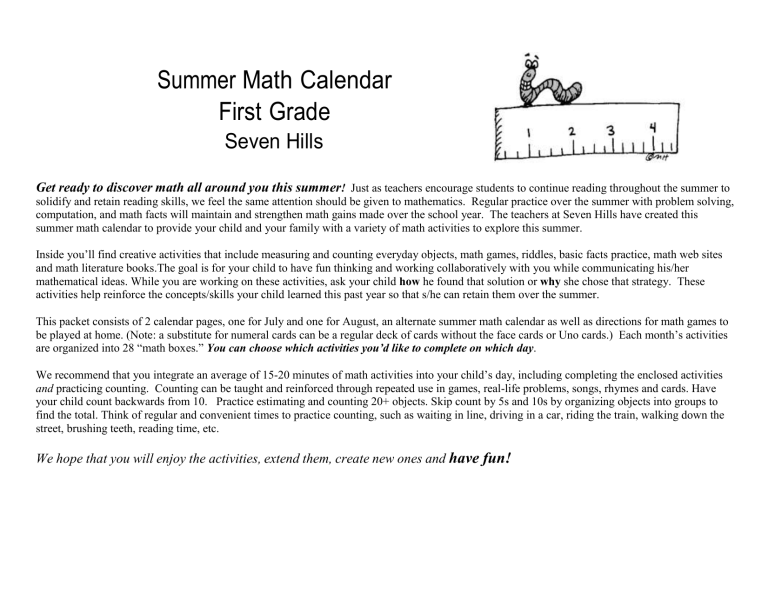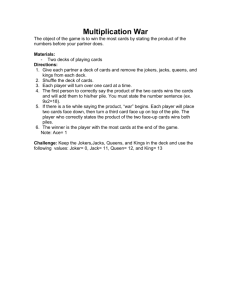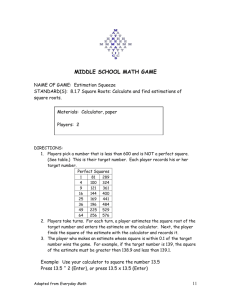Microsoft Word - First Grade coverpage.08.doc

Summer Math Calendar
First Grade
Seven Hills
Get ready to discover math all around you this summer
! Just as teachers encourage students to continue reading throughout the summer to solidify and retain reading skills, we feel the same attention should be given to mathematics. Regular practice over the summer with problem solving, computation, and math facts will maintain and strengthen math gains made over the school year. The teachers at Seven Hills have created this summer math calendar to provide your child and your family with a variety of math activities to explore this summer.
Inside you’ll find creative activities that include measuring and counting everyday objects, math games, riddles, basic facts practice, math web sites and math literature books.The goal is for your child to have fun thinking and working collaboratively with you while communicating his/her mathematical ideas. While you are working on these activities, ask your child how he found that solution or why she chose that strategy. These activities help reinforce the concepts/skills your child learned this past year so that s/he can retain them over the summer.
This packet consists of 2 calendar pages, one for July and one for August, an alternate summer math calendar as well as directions for math games to be played at home. (Note: a substitute for numeral cards can be a regular deck of cards without the face cards or Uno cards.) Each month’s activities are organized into 28 “math boxes.”
You can choose which activities you’d like to complete on which day .
We recommend that you integrate an average of 15-20 minutes of math activities into your child’s day, including completing the enclosed activities and practicing counting. Counting can be taught and reinforced through repeated use in games, real-life problems, songs, rhymes and cards. Have your child count backwards from 10. Practice estimating and counting 20+ objects. Skip count by 5s and 10s by organizing objects into groups to find the total. Think of regular and convenient times to practice counting, such as waiting in line, driving in a car, riding the train, walking down the street, brushing teeth, reading time, etc.
We hope that you will enjoy the activities, extend them, create new ones and have fun!
Summer Math
First Grade
Seven Hills
Directions: Complete any 20 math boxes each month. Color in the box after your complete it. Return the calendar grid to your new first grade teacher in September.
Books To Read This summer
▼
Benny’s Pennies by Pat Brisson
▼ Pattern Fish: by Trudy Harris
● Inch by Inch: by Leo Leonni
▼ Ten Flashing Fireflies by Philemon Sturges
● Two Ways to Count to Ten by Ruby Dee
ATTACH YOUR MATH
Games to Play with
Friends 0r Family
Compare or Double Compare*
Collect 20¢*
Turn Over 10 (or 6)*
*Directions for above games are included
The games below are available at stores
Uno
Monopoly Junior
Mancala
Blink
Dominoes
Toot & Otto
Batik
CALENDAR BELOW
SUNDAY
Sort the laundry (by owner, by color, by size, by item type)
Who in your family had the most socks in this load?
Play the game
Turn Over 10 (or 6).
Practice skip counting by 2s to 40
(2, 4, 6, …)
Read ▼ Pattern Fish by Trudy Harris
Draw, build or sing your own pattern.
Seven Hills First Grade Calendar
MONDAY
Make a picture using
2 circles, 3 triangles, and some rectangles.
Explain to a friend how you made it.
TUESDAY
Play the same game again with a friend.
Did you use a strategy? Tell someone about it.
WEDNESDAY
Play the same game again with a friend.
Did you use a strategy? Tell someone about it.
THURSDAY
Swing 50 times or jump 50 times.
How long did it take?
Can you count backwards?
FRIDAY
Read ▼ Benny’s
Pennies by Pat
Brisson.
What would (or could) you do with your pennies if you had some?
Play Turn Over 10
(or 6) again.
This time write down all the possible combinations that equal 10 (or 6).
Make a repeating pattern with seeds (or flowers on a piece of masking tape (sticky side up). Put the sticky ends together to make a bracelet.
Build something with blocks or Lego’s.
Decide how many you will use. Tell someone about the shapes you have made.
Practice counting on from numbers other than one.
Start at 4…
Start at 17…
Start at 32…
Can you count backward?
PARENT SIGNATURE:
Help set the table for a meal. How many people are there?
How many forks, spoons, and knives do you need?
Play Concentration on the web♦ with numbers
1-10 .
Record your matches.
♦ illuminations.nctm.org
Click on ACTIVITIES.
K-2. Search.
Read a book of your choice.
What math ideas do you find in it?
Count 25 objects
(Cheerios? raisins? rocks?)
Now make a pile of
15 from that 25.
How many are still left?
Play a number game with a friend.
Practice your +2 facts
1+2, 2+2, 3+2, 4+2…
Do you count on?
Go to a store or market with an adult. Make a list of all the fruits you would eat. Sort them by color.
Make a graph to show your sorting.
Read ● Inch by Inch by Leo Leonni.
What part of your body can you use to measure?
Play the same number game again. This time record the numbers
(or number combinations).
Count how many steps it takes to get from your room to the kitchen. Then try giant steps. How many more regular steps did it take?
Look in your food storage. Find 5 boxes of different sizes in your kitchen (cereal? pasta?).
Line them up from tallest to shortest. Now, line them up from thickest to thinnest.
Bring many sizes of containers to a sand or dirt place. Fill them up and compare their weights and the castles they make. Which is highest?
Play Five Frame on the web. ♦
Games: Fill a Frame
Record all the number sentences with a sum of five.
♦ illuminations.nctm.org
Click on ACTIVITIES.
K-2. Search.
CHILD’S NAME:
SATURDAY
Keep track of the weather this week.
How many sunny days? Rainy days?
Cloudy days? How many more sunny days than rainy days?
Take a walk outside.
Survey on paper how many insects, birds, and mammals you see.
Time your transitions by counting backwards.
“I will finish putting my shoes on in 20 seconds. 20,19,18…”
Play a game that uses dice.
Practice your addition facts that equal 6.
2+4, 3+3…Are there more?
SUNDAY
Jump 3 times, once like a bunny, once like a frog, and once like a child. Measure each jump. Which jump was the shortest? Longest?
Play Compare with a friend.
Practice skip counting by 2s and 5’s.
2, 4, 6, 8 to 30.
5, 10, 15, 20...to 50.
Tell a friend a story problem to go with
3+2. Then try a story to go with 5-2.
With chalk, make a repeating pattern design on a sidewalk or driveway near you.
Ask an adult first.
MONDAY
Play a game with a friend.
Practice counting backwards from big numbers. Start at 27.
Try starting at 40.
Play Double
Compare with a friend.
What is your strategy for comparing the total of two cards?
Play Ten Frame on the web. ♦
Games: Fill a Frame
Record all the number sentences with a sum of ten.
♦ illuminations.nctm.org
Click on ACTIVITIES.
K-2. Search.
Use different shaped containers and wet sand or dirt to build a repeating pattern design.
Can you label the pattern? ABAB;
AABAAB; ABCABC
PARENT SIGNATURE:
Seven Hills First Grade Calendar
TUESDAY
Play the same game again with a friend.
Did you use a strategy? Tell someone about it.
Start a collection of rocks or shells.
Estimate how many fit in your hand?
Count to see. Put them in order from smallest to largest.
Play a game with a friend.
Try counting by tens forward and backward.
Play Bobbie Bear on the web ♦ again
Choose: Customize
How many outfits can you make with 3 shirts and 3 pants?
♦ illuminations.nctm.org
Click on ACTIVITIES.
K-2. Search.
WEDNESDAY THURSDAY
How many utensils do you think you have?
Make a picture graph to show how many forks, knives, and spoons you have in your utensil drawer.
Try a game like basketball, bowling, or mini golf. Help keep score. Who had the most points? Is that the winner?
Play the same game again with a friend.
What about the game is mathematical?
Play a board game that uses dice.
Practice your facts that equal 6. 5+1,
4+2, 3+3, are there more?
Make a picture using
3 circles, 4 triangles, and a shape with more than 4 sides. Can you make it symmetrical?
Play Bobbie Bear on the web. ♦
Choose: Customize
How many outfits can you make with 2 shirts and 3 pants?
♦ illuminations.nctm.org
Click on ACTIVITIES.
K-2. Search.
Look at a calendar. How many days are left until school begins? How many weeks? Predict how many will be sunny, rainy, snowy or cloudy.
Can you find a way to keep track?
Play a board game that uses dice again.
Does any one of the numbers get rolled more than others?
Write your first and last name. How many letters in each? How many more letters in your long name than in your shorter one?
When you go out, count how many people are wearing shorts and long pants and compare. Why might that change on another day?
Read Two Ways to
Count to Ten by Ruby
Dee
How many ways can you count to ten?
Draw a picture to show this problem: I made 8 hot dogs. The kids ate 4 of them.
How many are left?
Can you make your own problem picture?
CHILD’S NAME:
FRIDAY SATURDAY
As you walk or drive in the car, try to find all the numbers
0,1,2,3…in order.
How many do you see along the way?
How high can you go?
Read Ten Flashing
Fireflies by Philemon
Sturges.
Instead of fireflies in a jar, count the veggies going into your mouth tonight.
Make a list of all the 2D and 3D shapes you can think of. Go on a scavenger hunt looking for those shapes. Check off the shapes you find.
Play the game
Collect 20 ¢ How many nickels can you use to make
20¢? How many pennies? How many dimes?
Directions for Games to Play with Friends or Family
Compare:
Materials: Deck of Number Cards 0-10 (or playing cards with face cards removed)
Object: Decide which number is largest.
How to Play: Divide all the cards evenly among the players. Each player puts out one card. The player with the largest number takes all the cards.
Variations: •The player with the smallest number gets all the cards.
• The players all keep their own cards but the one with the largest (or smallest) number says “Me”.
• Add wild cards to the deck. The player putting out a wild card can make it any digit (0-9).
Double Compare:
Materials: Deck of Number Cards 0-10 (or playing cards with face cards removed)
Object: Decide which total is greatest.
How to Play: Divide all the cards evenly among the players. Each player puts out two cards simultaneously. Each player announces his/her total.
The player with the greatest total takes all the cards.
Variations: •The player with the smallest total gets all the cards.
• The players all keep their own cards but the one with the largest (or smallest) total says “Me”.
• Add wild cards to the deck. The player putting out a wild card can make it any digit (0-9).
• Triple compare: Players each turn over 3 cards on a turn and add all 3 to find the total.
Collect 20¢:
Materials: Coins (pennies, nickels dimes), one die.
Object: Add on to your coin totals until you get to the decided amount.
How to Play: Decide on an amount of money to collect (15¢, 20¢, 25¢, 50¢). Players take turns rolling the die. The player announces the number rolled and takes that number of pennies. The next player rolls and adds his/her pennies to the collection. You can trade in pennies for nickels or dimes as you go along. The game is over when the collection equals the decided amount.
Turn Over 10
(This game is a variation of Memory or Concentration)
Materials: Deck of Number Cards 0-10 (or playing cards with face cards removed)
Object: Find as many combinations of two cards that equal 10.
How to Play: Place all the cards face down on a table in a rectangular arrangement (an array). Players take turns turning over two cards. If the two cards add together to make 10, the player keeps the pair. If the cards do not make 10, the player turns them back over. The game ends when all possible combinations have been taken.
Variations: •Turn Over 6 – Use only 0-6 cards and turn over pairs of cards that total 6.
• Use more than 2 cards to get to 10. If the first two cards turned over equal a number smaller than 10, the player continues to turn over cards until s/he reaches 10 or goes over. Note: This variation usually results in cards left behind which do not make combinations to 10.








